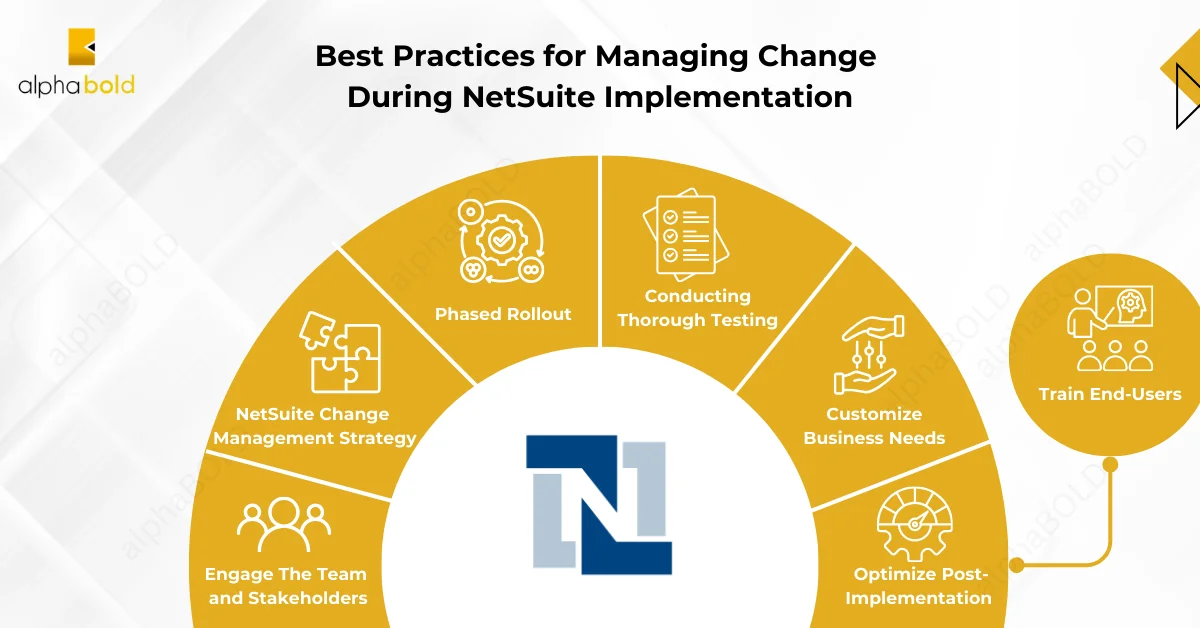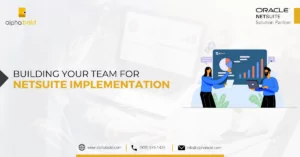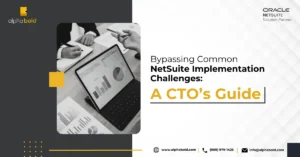Table of Contents
Introduction
NetSuite can undoubtedly help businesses streamline operations and enable data-driven decision-making. However, the success of NetSuite implementation depends heavily on an effective change management strategy. Without a structured approach, businesses risk encountering resistance to change and operational disruptions and missed ROI targets.
Implementing Change management isn’t confined to a single stage—it’s a continuous process throughout the NetSuite implementation lifecycle. From pre-implementation assessments to post-implementation support, addressing how NetSuite impacts workflows, roles, and operations is critical.
Organizations can ensure a smooth transition by proactively engaging stakeholders, aligning workflows with NetSuite’s capabilities, and monitoring adoption rates.
AlphaBOLD helps businesses understand these complexities with proven strategies for managing change during NetSuite implementation, driving measurable results and lasting success. Let’s explore some of these NetSuite implementation best practices, along with the significance of having a strong change management strategy for your ERP systems.
Why is Change Management for ERP Systems Important?
Implementing NetSuite can significantly transform business operations, contingent upon the effectiveness of a well-executed change management strategy. According to the 12th Edition of the Prosci Best Practices in Change Management, projects with a structured process and tools are 7 times more likely to meet objectives than those with poor change management.
Resistance to change is a common hurdle, whether from internal teams adapting to new workflows or external customers adjusting to updated processes. While NetSuite offers undeniable benefits — such as enhanced business operations and improved return on investment — organizations may encounter challenges, including resistance to change, operational inefficiencies, and the risk of low adoption rates among end-users.
To overcome these problems, businesses must prioritize a strategic approach to change management for ERP systems like NetSuite. Start by clearly explaining the rationale to the stakeholders. This will align them with the process and build trust.
An effective change management strategy ensures smooth transitions, reduced resistance, minimized downtime, and enhanced productivity and ROI. Following a step-by-step plan will help in managing change during NetSuite implementation. Let’s explore the key reasons why adopting a strong change management approach is essential.
Smooth Transitions:
A structured strategy can save businesses from chaotic software rollouts. Managing change during NetSuite implementation will be smooth and swift when every phase is pre-planned. NetSuite implementation best practices in change management also ensures employee readiness.
These smooth transitions also ensure employees’ readiness. Your team will feel confident embracing a new solution when you provide clear instructions on how this is going to help them and provide a structured onboarding of the platform. Proper management also prevents misaligned workflows by identifying and correcting mismatched processes.
Full Utilization of ERP Capabilities:
Effective change management is essential for fully adopting ERP capabilities. It enhances feature adoption, enabling teams to familiarize themselves with relevant functionalities that align with their needs and objectives.
Implementing targeted training programs can help mitigate the risk of underutilizing ERP features, allowing for the timely resolution of any challenges encountered in NetSuite. Moreover, by leveraging the real-time data insights provided by NetSuite, teams can identify opportunities to optimize business operations and processes.
Read further: NetSuite ERP Financials: Features, Capabilities and ROI
Aligns Organizational Goals:
Change management for ERP systems is essential for aligning functionalities with an organization’s strategic objectives. This approach facilitates the integration of business goals and enables measurable outcomes. Furthermore, by promoting cross-functional collaboration, change management effectively bridges operational silos and enhances workflows among various departments.
Minimizes Downtime:
With effective change management, businesses can significantly reduce downtime during ERP implementation. A well-managed transition ensures that operations run smoothly, preventing costly interruptions that could disrupt workflows and impact productivity. Organizations can maintain their competitive edge by minimizing downtime, ensuring customer service and operational efficiency remain unaffected throughout implementation.
Increases Productivity:
Managing change during NetSuite implementation helps understand the full potential of ERP capabilities and increases team productivity. When employees embrace the system, streamlined processes and better team collaboration improve productivity. Furthermore, leveraging real-time data and insights enhances decision-making, delivering measurable financial returns. Organizations can maintain their competitive edge by minimizing downtime, ensuring customer service and operational efficiency remain unaffected throughout implementation.
Simplify NetSuite Change Management With a Trusted Partner
Implementing NetSuite without a proper change management strategy can be challenging. AlphaBOLD offers customized NetSuite support services to address these issues.
Contact UsSuccessfully navigating change management for ERP systems requires a well-structured approach. Let’s explore the best practices that will help your organization maximize the benefits of your NetSuite implementation.
Best Practices for Managing Change During NetSuite Implementation
Effectively managing change during NetSuite implementation ensures a smoother transition, higher adoption rates, and long-term success. By following proven NetSuite implementation best practices, businesses can maximize the system’s potential while minimizing disruptions and resistance to change.

1. Engage The Team and Stakeholders From the Start:
The objective an effective strategy is to proactively identify and address potential challenges, with a key focus on minimizing resistance to change. Facing reluctance to change is expected. However, engaging the team and stakeholders and explaining how these changes will impact individuals, their workflows, and overall business success can convince their minds.
Addressing resistance to change should be prioritized when managing change during NetSuite implementation. We recommend transparent and open dialogue to build confidence in your team. Such practices help alleviate skepticism and increase enthusiasm in the team.
2. Create A Structured NetSuite Change Management Strategy:
A structured framework provides a roadmap for guiding your organization through the transition. It aligns organizational goals with the ERP implementation process, clearly defines roles and responsibilities, and ensures all stakeholders understand their part in the system’s success. This strategy reduces ambiguity, builds consensus, and mitigates resistance to change.
3. Phased Rollout:
Implementing NetSuite in a phased manner minimizes risks and disruptions by focusing on one module or process at a time. This approach allows businesses to identify and address challenges in smaller stages, ensuring a more controlled transition. A phased rollout also helps employees adapt gradually, improving user adoption and confidence.
4. Conducting Thorough Testing:
Thorough testing ensures the ERP system aligns with your unique workflows and business processes. From integration testing to user acceptance testing (UAT), each phase identifies potential issues before they impact operations. Comprehensive testing enhances system reliability, reduces downtime, and ensures a seamless implementation.
5. Customizing for Business Needs:
Tailoring NetSuite to match your organization’s workflows and requirements ensures the system fits seamlessly into daily operations. Customization enhances usability, aligns the ERP with your strategic goals, and empowers teams to maximize its capabilities.
6. Monitor and Optimize Post-Implementation:
Change management doesn’t end after deployment. Monitoring system performance and user adoption ensures the ERP delivers its full potential. Businesses can identify improvement areas by analyzing feedback and key performance indicators (KPIs), refining workflows, and maintaining optimal efficiency over time.
7. Train End Users:
Comprehensive training programs are critical for driving adoption and ensuring employees utilize NetSuite effectively. Tailored training based on roles and responsibilities helps teams understand how the system benefits them individually and collectively. Ongoing support further solidifies confidence, improving productivity and reducing resistance.
Achieve Seamless NetSuite Implementation & Adoption
AlphaBOLD helps you smoothly implement NetSuite without any resistance or chaos with expert NetSuite implementation and support services.
Request SupportExplore: Engineering Change Order in NetSuite
Conclusion
Managing change during a NetSuite implementation is essential for ensuring a smooth transition, high user adoption, and long-term success. By proactively addressing resistance, engaging stakeholders early, and following NetSuite implementation best practices, businesses can maximize the system’s potential while minimizing disruptions. A well-structured approach to change management not only streamlines the implementation process but also helps organizations realize the full value of their technology investment.
AlphaBOLD is a trusted partner for organizations seeking expert NetSuite implementation services. With our extensive knowledge of ERP systems and change management, we provide tailored solutions designed to facilitate a seamless and successful transition to NetSuite. Our commitment to experience-backed strategies, comprehensive NetSuite support, and a results-driven approach ensures that we effectively meet your organization’s specific needs.
Explore Recent Blog Posts









